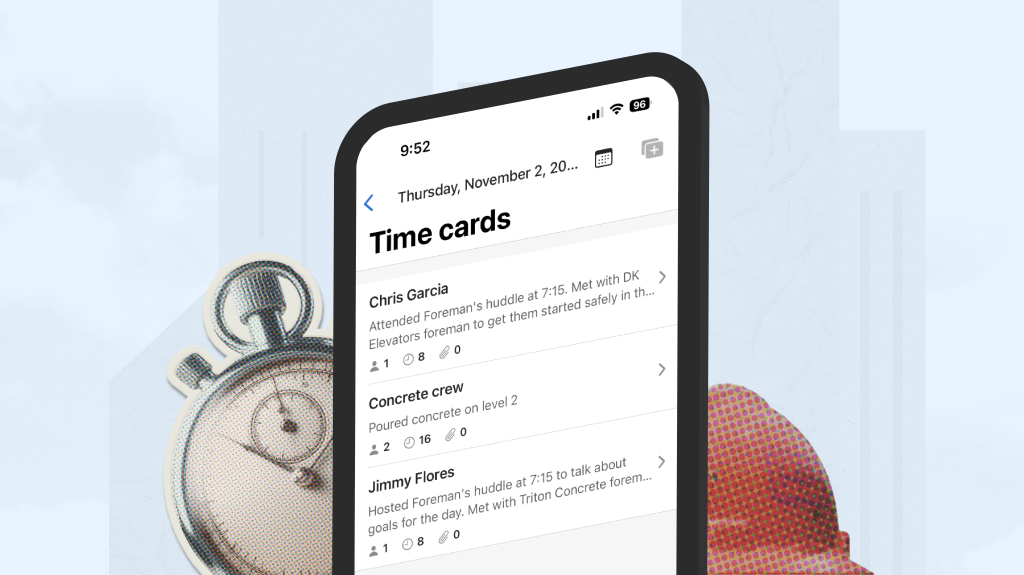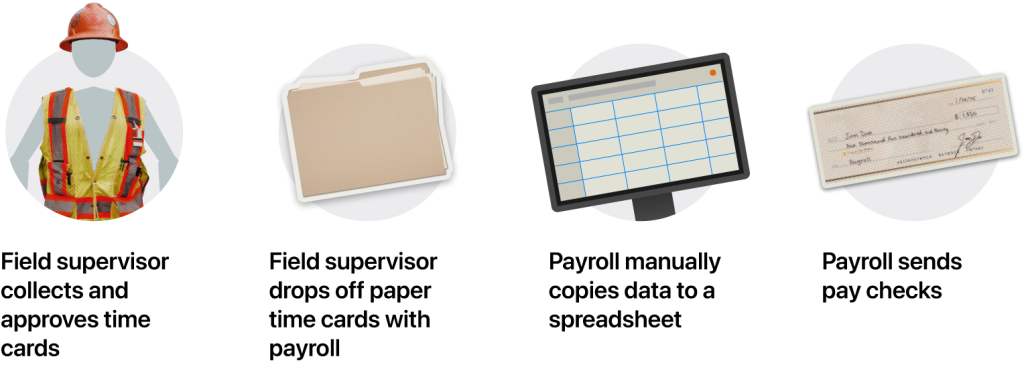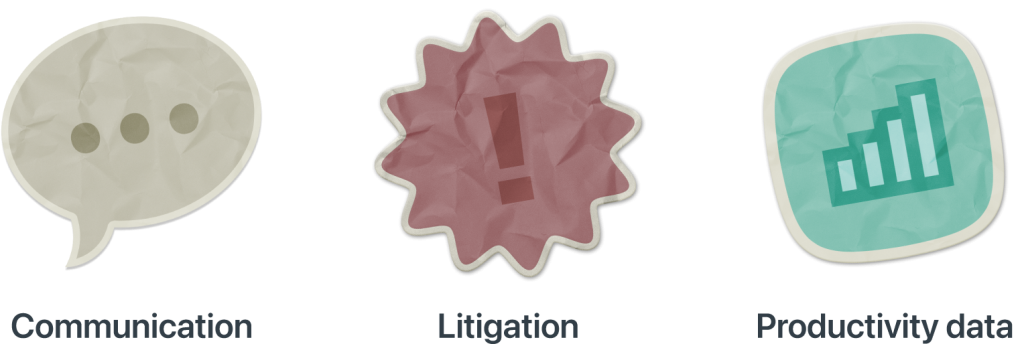
Time cards, also known as timesheets, are essential on every construction jobsite.
This guide covers how to improve the process of collecting time data from the field-as well as how you can get the most out of time card data to improve your business.
Why are time cards important in construction?
Time cards serve a very practical purpose in construction—tracking employee hours so they are paid accurately. But in terms of construction management, the benefits go beyond the sole purpose of paying employees.
Here are a few more reasons time cards should be a priority for any construction business.
Employee retention

When employees are consistently paid accurately and on time, they know they are valued at a company. Underpay an employee-or pay them late-and workers are quick to find employment elsewhere. Still, many construction companies struggle with payroll and have higher employee turnover rates as a result.
With an ongoing skilled labor shortage, employee retention is more important than ever. Losing any employees can significantly impact your ability to finish a project on time.
The time card process can also impact employee retention in the office—a stressful payroll process can lead to burnout, causing a high turnover rate in accounting.
Accurate job costing with cost code data
When cost codes are incorporated with time card data, you get clearer visibility of project performance. Workers will track the time they spent on tasks to specific cost codes, so you can see exactly how much labor it takes to complete them.
Receiving this type of information allows you to check on productivity throughout projects—providing real-time data to make more informed decisions.
Better estimates for future projects
Time card data can also help you plan ahead—especially when it’s easily accessible and clearly organized.
Time data that includes detailed information on time spent on projects, broken up by cost codes, helps you make better estimates for future projects, ultimately allowing for a greater financial return.
Recommended Read
How to Improve Your Construction Timesheets (and Save Money)
Learn how to improve the way you track time on every project.
How payroll teams use construction time cards
Now that we’ve covered the importance of time cards, we’ll take a look at how they’re collected and used by payroll teams.
The payroll process

While every company’s payroll team will do things a little differently, the payroll process usually looks something like this:
Workers or their supervisors track time in the field
Payroll collects, reviews, and organizes time card data
Workers or their supervisors approve finalized time cards
Payroll sends pay checks
While this seems straightforward, remember that tracking time and collecting that information involves significant communication and coordination between workers on the jobsite, their supervisors, and the office payroll team.
Time entry options
There are many different ways for workers to log hours and create time cards. Many businesses use a mobile time clock app to allow workers to track time on their individual mobile devices or they provide a shared time clock kiosk for clocking in and clocking out. For smaller businesses, it may make more sense for supervisors to track time for their crews using traditional pen and paper or digital time cards.
It’s up to you to determine how time will best be captured on your jobsites and how it will be shared with your accounting team. You’ll also need to communicate those processes, provide the proper tools and training, and make sure employees understand their obligations.
Payroll pulls attendance and productivity data
Assuming you’ve chosen an effective method for creating time cards and this process runs smoothly, your payroll team should be able to organize time data and share valuable insights with management, including:
Attendance
Hours spent on projects
Gross earnings
Payroll compiles data, ensures there are no errors, and passes this data onto management—so they can plan for more profitable projects in the future.
Recommended Read
How Kyne Construction Uses Raken + FOUNDATION to Streamline Payroll
Learn how Kyne Construction improved their payroll processes with data collection and payroll software.
Common problems when using construction time cards
From subcontractors to CEOs, timesheets provide value to everyone in a company—from employees receiving payment, to management receiving quality data to plan future projects.
It's important for the payroll process to run smoothly, so that your company can focus on moving projects forward. However, many companies experience issues collecting or using time cards. These are a few examples of common problems in the payroll process:
Chasing after paperwork
Manual entry
Talent drain
Inaccurate data

Chasing after paperwork
Most construction companies have experienced chasing after paperwork at some point. Collecting and hunting down paper time cards can take up a significant amount of time for payroll, especially since this is a recurring task.
Manual entry and re-entry
With paper time cards, payroll must manually transfer all data onto a computer. This can be a tedious process, and manual (or double) entry can lead to errors. Aside from time, needing to review work to find an error can be incredibly frustrating.
Alternatively, the error may go unnoticed, and you are left with inaccurate data to base future projects off—which can be costly for your company.
Even if you use a digital method for tracking time, it may not be integrated with your accounting software. In that case, the payroll team will still need to manually transfer data from one system to another, increasing time spent and your margin for error.
Resource and talent drain
Because most employers realize the importance of paying employees on time, some construction companies will use all their resources to help payroll complete payments on time.
Companies that pull employees who don’t work in payroll to help payroll deliver payments are wasting valuable resources (time and money), as well as talent. If a company ever needs to put other projects on hold in order to pay employees, improving the payroll process should be a top priority.
It should go without saying that payroll is only one part of an accountant's job. If your finance team is spending a majority of their time on payroll, they can’t take the time to look at big picture issues that could grow your business’s revenue.

Underpaying or overpaying employees
Simply trying to do things faster is not the answer, though. Hastily paying employees, or an unorganized payroll process, can also mean overpaying employees. This may keep employees happy, but it can also cause significant damage to your company's budget over time.
On the flipside, underpaying employees is another possibility with more immediate side effects, as disgruntled employees are quick to find work elsewhere.
Inaccurate or little cost code data
Another side effect of a rushed payroll process and manual entry is a lack of reliable data. If payroll or superintendents are rushed, data may not be well organized or even documented.
Writing cost code info using pen and paper on a busy jobsite isn't the easiest task. This means you won't have real-time knowledge of project productivity, or the insights to make more accurate estimates for future jobs.
Recommended Read
Construction Cost Codes: The Ultimate Guide
Learn how and why to implement cost codes on your next construction project.
How digital solutions make construction time cards more efficient
Understanding the importance of time cards means you can prioritize making this an efficient and reliable process and avoid the common issues that make payroll a time-sucking task.
By improving time card and payroll processes, you will inevitably improve the overall efficiency and organization across your company. Here are a few ways you can get started:
Field-based data collection
Want to improve communication between the field and office? Field-based tech can make it easy for field crews to quickly enter and send time card data to the office for real-time visibility. Being able to quickly enter data onto a phone or tablet allows supers to enter more complete, consistent data.
Digital time cards and time clocks also eliminate the need for payroll to chase supers down to collect paper time cards, or verify data or approvals. Digital time cards—designed to be easy to use in the field—make life easier for supers and payroll, so everyone is happy.
More accurate job costing with cost code data
Time card technology can make it easy to include cost code information, with some software even providing insights into job productivity. Productivity insights give you more project visibility with cost code comparisons and real-time data.
Remove the need for manual re-entry
Submitting digital time cards means payroll no longer has to copy data over to a computer. Not only does this save a significant amount of time—it also eliminates the opportunity for error caused by entering information incorrectly. Plus, when your time card software integrates with your payroll software, even more time is saved.
Preset permissions and time card locking
Time card software often includes permissions and time card locking, so that you never have to worry about someone editing time card data after it's been approved. That means payroll teams can be confident they get the most accurate time data for payroll processing.
Centralized views of time for employees, supervisors, and payroll teams
Digital solutions often allow for great visibility for everyone on all sides of the business.
Software can organize assigned tasks and previously tracked time into centralized views for employees and supervisors who manage their employees’ time to see what’s going on across projects. This improved awareness makes it easier to spot potential conflicts and schedule work more efficiently, improving productivity.
Payroll teams can also use these holistic views to quickly identify and resolve potential errors or conflicts before they result in inaccurate paychecks.
Benefits of digital construction time card data

We've already mentioned a few benefits of time card data, but let's talk more specifically about the benefits you'll undoubtedly see when using the right tool to digitally collect time cards.
Improved communication with stakeholders
Have you ever had to explain unexpected project delays to stakeholders, weeks after they occurred? Knowing where projects stand in real time means you can keep stakeholders up-to-date on all changes to project timelines—and correct any inefficiencies before they add up.
Litigation protection
At the end of the day, no matter how well you communicate with stakeholders during a project, there's always a chance a dispute will arise afterwards. Having digital time cards means you have organized evidence of all the work put into a project—making it easy to prove work completed.
On a day-to-day basis, you also have real-time visibility into any work hours that are outside the original project scope. This means you can ask for payment, or make changes to improve time efficiency, as project changes occur.
Project productivity data
Construction projects are constantly moving, making it near impossible to find several hours of free time where you can sit down to analyze data. Thankfully, digital tools are incredibly helpful when it comes to analyzing and understanding data.
“Raken has improved the time that it takes to do time cards and the overall accuracy. The number of pay complaints from our employees are down to zero.”
With the right tools, you can have real-time access to productivity data, giving you the ability to:
View time spent on each cost code
Compare hours worked against timeline goals
View financial impact of overtime hours
Often, you can combine time card data with other productivity data for even more insights—so you have complete visibility into financial spend and performance at a glance.
Recommended Read
The Ultimate Guide to Production Tracking
Learn how digital production tracking can improve project visibility with accurate data and production insights-all in real time.
Construction time card software
What features should you look for in digital construction time card software?
Make sure the tools you choose allows for:
Mobile data collection
Unlimited custom cost codes
Overtime management
Automated insights
Integrations
Mobile data collection
The first rule of implementing any software in construction is that it has to be easy to use and access.
Whether you want to use digital time cards, a mobile time clock, or a shared kiosk, software should make the data collection process easier, not over-complicated. Look for a simple user interface that works via any mobile device, so your crew can track time in the field using the devices they have in their pockets every day.
Unlimited custom cost codes
Time card software for contractors needs to be flexible to be most effective. The more granularly you track time, the more insights you'll have to support hiring and purchasing decisions.
When you can add unlimited custom cost codes to time cards, you can track work hours exactly the way your business needs. You can evolve your processes with the business, and you aren't forced to track time by the software developer's requirements.
Overtime management
Managing overtime, double time, and any other kinds of pay rates can be a pain, especially across multiple service areas with different laws and requirements.
Your construction time card software should help you manage overtime by setting rules and automatically applying them based on the project.
Policy management
You should easily be able to adjust policies for pay types, break, and more per project or employee—however makes the most sense for the size and service area of your business and the way you operate.
The larger your business is, the more flexibility you’ll likely need. And if your digital time cards can’t provide that, there’s a limit to how efficient they can actually be.
Identity and location verification features
It’s an unfortunate reality that some employees may deliberately attempt to commit time fraud and falsely report their hours worked. There are also instances where time theft is the result of miscommunication or misunderstanding.
Digital time cards can prevent both intentional and unintentional errors with features that help verify the identity of employees and the location at which they clock in or out.
You may also be able to include customized questions for employees to sign off on each day that will reinforce proper procedures.
Automated insights
Some construction time card solutions go the extra mile, consolidating time card data and helping you apply it.
Automated insights demonstrate how work hours are spent and what that means for project progress.
Integrations
Your time card software should integrate with your accounting system to reduce manual data entry and prevent payroll errors.
Get the most out of your construction time cards with Raken.
Our easy-to-use digital time tracking app saves valuable work hours for the field and office.